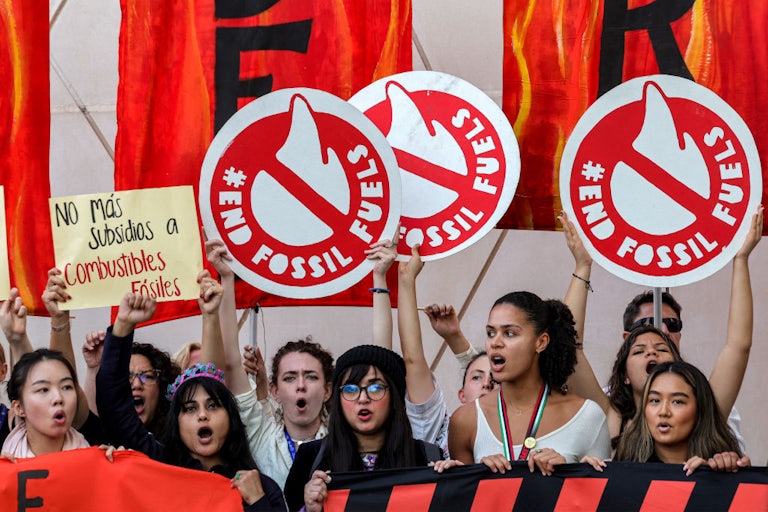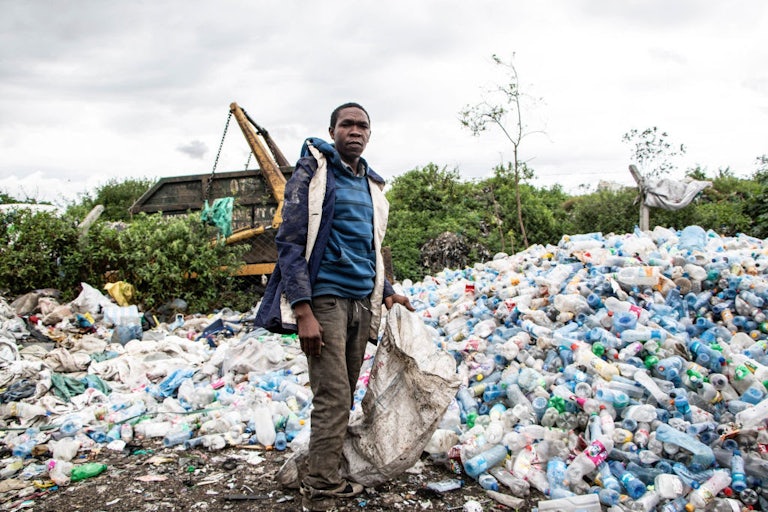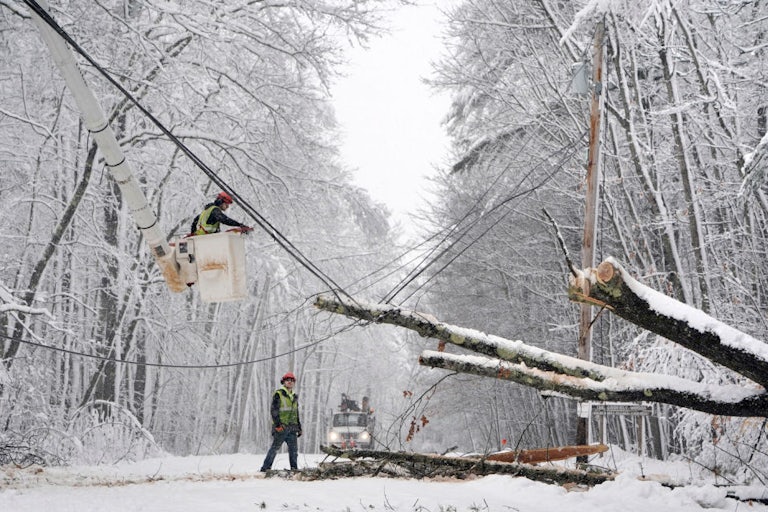The COP28 Climate Deal Is Lipstick on a Pig
The UN process for averting planetary collapse is broken. Here are some ideas for fixing it.

Mona Ainu’u is the minister of natural resources for Niue, an island nation of about 1,600 people in the South Pacific. On Monday, she was reportedly in tears as she reacted to the latest draft produced by the U.N. climate conference, which omitted the words “fossil fuel phaseout.” “My 12-year-old, what am I going to say to her when I come back?” Ainu’u asked. Niue is particularly vulnerable to sea-level rise, which could easily jeopardize its fresh water supplies.
That same day, another 12-year-old named Licypriya Kangujam stormed the COP28 stage bearing a sign calling for an end to fossil fuels. “Millions of children like me are losing their lives, losing their parents, and losing their homes due to climate disasters,” shouted Kangujam, who lives with her family in Noida, a city about 12 miles southeast of the Indian capital of New Delhi.
“We’re very proud of the enthusiasm of the young people who have joined us at COP28, and let’s give her another round of applause,” said COP28 director general Majid Al Suwaidi, after Kangujam was hauled out. Then, according to Kangujam’s social media feed, her COP28 badge was revoked and she was kicked out of the conference.
On Wednesday, headlines trumpeted the “historic” and “unprecedented” deal that negotiators at COP28 reached after working throughout the night, finally agreeing on a text that calls for “transitioning away from fossil fuels.” It didn’t say “phaseout,” as many vulnerable nations wanted, nor is the agreement binding, but it was the first time ever that a U.N. climate agreement has explicitly called for a decrease in fossil fuels. As such, it will be perceived in many quarters as a victory. Yet veterans on this topic know that this outcome isn’t enough: “Overall, I think this is a stronger text than the prior versions we have seen,” the U.N. Foundation’s senior adaptation adviser, Cristina Rumbaitis del Rio, told Al Jazeera. “But it falls short in mobilising the financing needed to meet those targets.”
In the past week, a lot of ink has been spilled on how the U.N. climate conferences got this bad and whether there’s any way to make them better. But it’s hard to think of a better encapsulation of what’s wrong with the conferences than this tale of two 12-year-olds against the backdrop of 2,400 COP28 badges awarded to participants from the fossil fuel industry.
The first Conference of the Parties, or COP, held in 1995, involved a few thousand “diplomats and scientists,” The Washington Post reported this week. In recent years, that has ballooned to an 84,000-person traveling circus that business lobbyists now see as a prime networking opportunity. “The negotiations, we’re not really part of that,” Chamber of Commerce senior vice president for policy Marty Durbin told the Post. “But we do have the opportunity to meet with officials and other companies and dig into these critical issues.”
How best to kick these grifters out is the subject of some debate. Ideally, as a starting step, the conference would ban absolutely all representatives of fossil fuel companies. But that’s hard to do when some may be part of official national delegations.
Michael Mann and Susan Joy Hassol, writing in the Los Angeles Times, demand an “overhaul of the COP rules and processes. It’s almost embarrassing to have to explicitly state, for example, that petro-states—those whose economies heavily depend on the extraction and export of oil and gas—should not be allowed to host the meeting. Given the enormous conflict of interest, oil industry executives should not be allowed to heavily influence, much less preside over, the summit.”
That is hard to argue with, although, as TNR’s Kate Aronoff recently argued, the United States should probably be considered a petrostate too: It’s the top producer of oil and gas in the world. And while the U.S. economy may be more diversified than that of some petrostates, the sector still accounts for 8 percent of the nation’s gross domestic product. It’s unlikely that the U.S. is going to throw its weight behind any reform that tells states like itself to sit down and shut up. (If Donald Trump wins reelection, that may be a moot point, as he’ll probably withdraw the country from the conferences entirely.)
There are other, more procedural ideas for how to improve these meetings. Former U.N. Framework Convention on Climate Change executive secretary Christiana Figueres said earlier this year that while “multilateral engagement” was the point of the original COPs, it’s now “distracting governments from doing their homework at home.” Experts surveyed by Grist’s Tik Root suggested smaller “working groups” or “sectoral agreements”—like one regulating methane—in lieu of big conferences on total emissions targets.
Subash Pandey, writing in The Kathmandu Post, suggested taking the entire group of nonstate actors and giving them their own event at a different time and place—still “under the UNFCCC’s purview”—so that the state negotiators can do their work in relative peace. Although this would kick out a lot of NGOs and activists as well, there might be an added benefit. “Smaller COPs,” Pandey wrote, “would make hosting these events more accessible to smaller and less affluent nations. Consider countries like Nepal, which currently may struggle to organize COPs that attract tens of thousands of participants. Small COPs would provide a unique opportunity to host COPs, showcasing the real and immediate impacts of climate change, particularly in regions like the Himalaya.”
None of these reform ideas are perfect. Kicking out all nonstate actors, for example, would leave a lot of state actors with personal or professional ties to industry, while excluding climate justice advocates and others seeking to amplify more vulnerable voices. But a policy that cuts attendance drastically so that less wealthy nations have a chance of hosting would make voices like Ainu’u’s and Kangujam’s harder to ignore.
Who knows whether, reform or no, it’s possible for the assembled states at these meetings to agree on anything substantive and binding, or for the lumbering and unjust political structure of the U.S. to pass a law enacting it. But at a bare minimum, delegates should probably be forced to confront the consequences of their inaction in the airports they fly into, the streets they traverse on the way to the conference center. They should be deliberating surrounded by reminders of fossil fuels’ destruction, rather than monuments to the immense wealth these fuels have created for a select circle. People condemning their more vulnerable brethren, as well as subsequent generations, to danger, hunger, instability, sickness, exile, or death shouldn’t be “comfy” while they’re doing it. And they shouldn’t be able to dismiss the vulnerable with a round of applause and a revoked badge.
Good News/Bad News
![]()
![]()
Stat of the Week
1/4
That’s the proportion of the world’s freshwater fish at risk of extinction due to climate change and other human-caused disruptions, according to a new report.
What I’m Reading
Biden Should Abolish Secretive Corporate Tribunals that Bypass the Law
Investor-state dispute settlements, or ISDS, allow corporations to essentially sue a government for “policies that reduce their profits,” Molly Taft writes. These processes take place in private and then the corporations are compensated with taxpayer money. And if governments, including the U.S., are serious about fighting climate change, Taft argues, these settlements should be scrapped:
Giving powerful corporations the ability to leapfrog international judicial systems and keep major rulings secret in pursuit of profits may be a fair trade-off to the Journal’s editorial page. But activists warn that the potential applications of ISDS are especially dire when it comes to the climate crisis. A 2021 analysis by the International Institute of Sustainable Development of more than 1,200 publicly available ISDS cases dating as far back as the 1970s found that the fossil fuel industry used the ISDS process more than any other industry, bringing around 20 percent of all cases, and that the majority of these cases were decided in favor of investors.
Read the rest of Molly Taft’s piece in The Nation.
This article first appeared in Life in a Warming World, a weekly TNR newsletter authored by deputy editor Heather Souvaine Horn. Sign up here.





.png)




